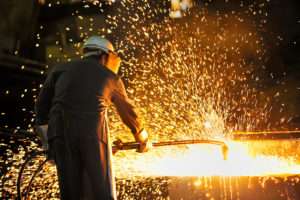
Fire Safety on Construction Sites
On October 23, 2019, the center of Auckland was blanketed by a thick cloud of smoke. Soon it was reported that the fire had engulfed the unfinished roof of the New Zealand International Convention Centre, the largest construction project in the country at the time.
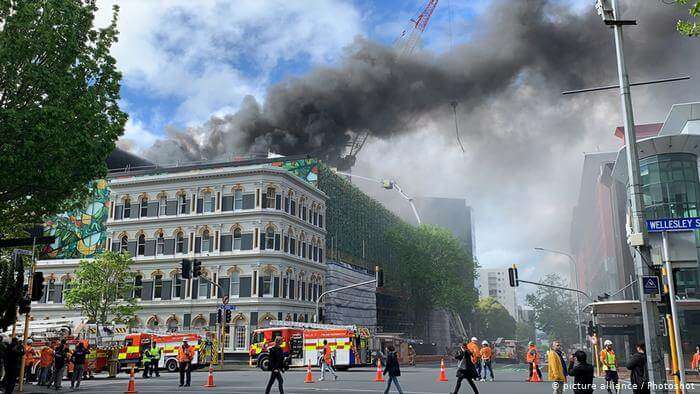
Smoke rises from the roof of New Zealand International Convention Center in Auckland
Image Source: Deutsche Welle
It was believed that the fire was “caused by a blowtorch being used on the convention centre’s roof”. It took more than 22 hours to extinguish the fire. One person received burns. Fortunately, no one was killed.
However, the financial and economic outcomes of this incident were devastating.
The top levels and the roof were significantly damaged, and there was also extensive damage caused by water. The center was supposed to host conferences and conventions; the opportunity to boost economic activity in New Zealand was now lost. Shares of SkyCity Entertainment Group, which owned this $449 million project, dropped right after the news about the fire was out.
The sad news is – headlines about construction site fires come from every corner of the world: from Australia, through Europe, Asia, Canada, all the way to the USA.
In numerous cases, fires cause disruption of regular building work and force builders and contractors to shoulder unexpected costs. The damage can usually run into millions and eliminate any chances of financial recovery. Fires in structures under construction and in structures undergoing major renovation can cost property loss, injuries, and even lives.
That’s why part and parcel of workplace safety management is designing a fire safety plan based on the identified fire hazards.
But before we move on, let’s understand why building sites need specific fire precautions.
Why Construction Sites Are At High Fire Risk
Usually, there is a lot of focus on the fire safety of ready to be occupied buildings. However, construction sites need the same amount of attention, because buildings under construction or major renovation are vulnerable to fire. There are at least four major factors that account for such vulnerability.
First, the structure itself is incomplete and there is a high risk of collapse should a fire break out.
Secondly, construction sites house chemicals, combustible materials, heavy equipment which can be sources of ignition or explosion. Something as small as metal sparks can create a fire hazard.
Thirdly, a construction site is usually open, so it’s less protected by walls and doors to stop or slow down the fire. The fire can also change direction quickly posing even more risks to physical structures and human lives.
Finally, firefighting operations on a construction site present challenges, mainly, related to site access, site information, and site navigation, because the buildings are not complete yet and the building site is constantly changing.
Fire can be a threat not only to buildings under construction but also to those under major renovation or demolition.
Unfortunately, examples are ample.
The building that caught fire in Circular Quay, Sydney, at the corner of Pitt Street and Alfred Street, was undergoing demolition to make way for a new high-rise apartment building.
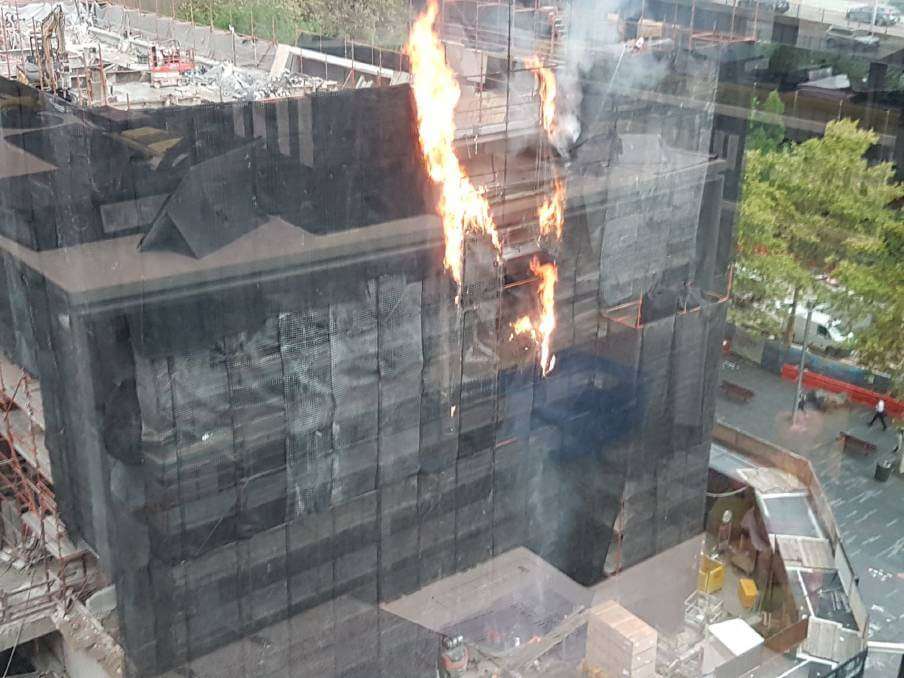
Building’s scaffolding in fire. Circular Quay, Sydney
Image source: The Canberra Times
“Numerous gas cylinders exploded during the blaze” which is another aspect to be considered when creating your fire management plan. Explosive and high-risk materials and liquids should be managed properly, having fire safety precautions in focus. More about this in a minute.
To be able to mitigate and control fire risks, it’s important to understand the basics.
For any fire to start, three elements are important: fuel, heat, and oxygen. Take away one of them, and the fire will not start or be able to spread.
These three components make up what is known as the ‘fire triangle’ or the ‘fire tripod’.
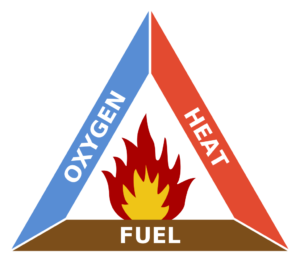
The Fire Triangle
Image source: Wikipedia
For example, you can suppress and put out a fire by removing the oxygen. Alternatively, you can use water to cool the fire down, remove the heat, and as a result, extinguish the fire.
Most construction sites are potentially at high fire risk because all of these three elements are readily available there. It’s practically impossible to control oxygen on construction sites, that’s why your attention should be concentrated on eliminating or managing heat and ignition sources.
What Can Cause A Fire On A Construction Site?
Electrical Malfunction And Lighting
In fact, one of the biggest construction fires in recent times occurred in April 2019, at Notre Dame Cathedral — an 850-year old structure, which had been going major renovation at the time of the fire.
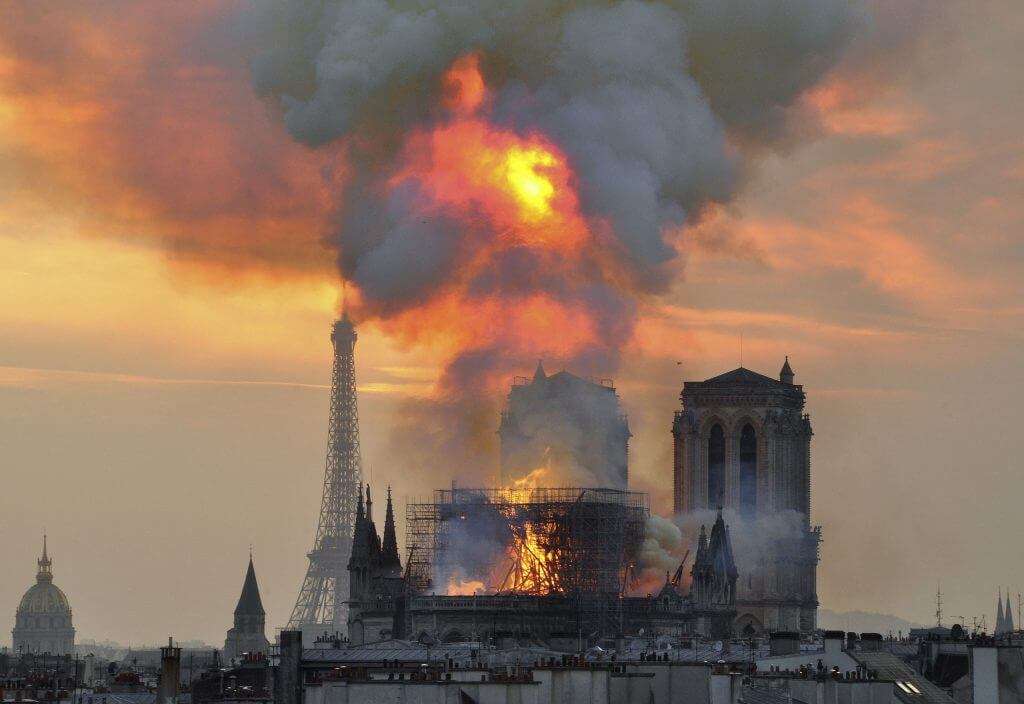
A massive fire on Paris’ famous Notre Dame Cathedral
Image source: Medium
Investigators think that “an electrical short-circuit most likely caused the fire”.
The building you are constructing may not have the same historical and cultural significance, but fire safety management should be done on the highest level.
Electrical installations must be placed at suitable intervals and be properly tested. Regular inspection is needed to locate any inadequate wiring, exposed electrical parts, damaged insulation, overloaded circuits, etc.
Place lighting units away from combustible material so as not to create a fire hazard. Pay special attention to high-intensity lighting, such as halogen and metal halide fittings.
Hot Work
Open flames are usually involved in hot work. Most commonly, the main hazard comes from sparks that can ignite into a fire. This method is used on construction sites if no other alternative is possible due to the fact that they pose a significant fire risk.
Examples of hot work include welding, brazing, soldering, thawing pipes, the use of hot air blowers, etc.
When dealing with hot work, remember that “you can move from being safe to unsafe in less than a second”. So, allow the tools and heaters to cool down after each use and store them in a dry location. And never leave heaters unattended while in operation.
Another example from Sydney…
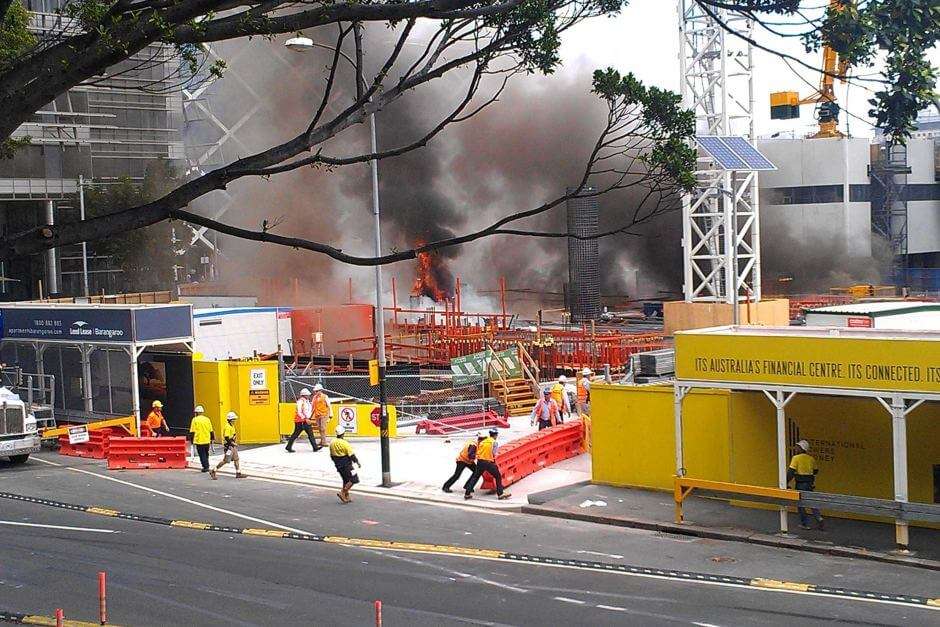
The fire at the Barangaroo construction site in the Sydney CBD on March 12, 2014
Image source: ABC
Fire in a building under construction at Barangaroo site “sparked thousands of evacuations and traffic chaos” on a Wednesday afternoon, in 2014. It was believed that “a welding accident sparked the fire” on the construction site.
Smoking
We’ll keep this point short. Smoking on the construction site should be banned. If needed, you can have designated smoking areas away from the worksite.
Arson
Arson is “the willful and malicious burning of property”. It’s said to be one of the easiest crimes to commit because even young children can do it. Besides, it’s difficult to decide whether the fire was arson or not, because it’s not an easy offence to investigate.
Although arson is difficult to detect and prove, there are fortunate cases in the industry when arsonists were identified and taken to custody.
A 45-year-old man was arrested in November 2018. He was accused of setting “one of the nine suspicious fires at housing construction sites” in Oakland, California.

Fighting the fire at a housing construction site in Oakland, California
Image source: The East Bay Express
Interestingly, the man who was put in custody was a construction worker. This means work on a construction site should be controlled and supervised to ensure everyone’s safety.
Taking The Needed Fire Precautions On A Construction Site
You basically need to complete the following three major tasks:
- Prevent fire (for example, by installing smoke detectors)
- Have a system in place to control fire in case it breaks out (for example, by installing fire sprinklers and fire hydrants)
- Train your staff on what to do in the event of a fire.
What on-site workers do in the event of fire depends on how well they are prepared for it.
They can panic not knowing how to extinguish small fires or find the emergency exits.
Alternatively, they can grab their gadgets to take photos without having a clear idea of what’s going on (we hope it’s rare, but it’s still an option). And they can clearly know what should be done to leave the site quickly and damage-free.
We need cool heads to act correctly in an emergency. But above all, we need a viable fire management plan.
First, let’s see what the law says.
The National Construction Code (the NCC) Volume One Section E1.9 “Fire precautions during construction” states that fire precautions are mandatory for any Class 2-9 buildings.
You are required to install suitable fire extinguishers on each storey of the building (in any stage of construction work of any size).
Choosing the right type of extinguisher is extremely important. Fire extinguishers may use dry powder, foam spray, water and CO2, so there are dos and don’ts to keep in mind which are presented in the chart below:

Classes of fire and what is the best fire extinguisher to use
Image source: FireSafe
Two important notes here: you should use fire extinguishers only in case of small fires and when it’s in the initial stage.
Second, regularly inspect fire extinguishers (ideally at least every 6 months) to make sure they are in proper condition and working. A fire extinguisher is no good if it doesn’t work when you need it.
Other types of firefighting equipment include the fire blankets, fire hose reels, and fire hydrants.
Fire blankets are known as the first line of defence from fire. They are designed to extinguish incipient (starting) fires or control small fires. Fire blankets are made of a highly flame-resistant blanket. You can use them to cover a burning material. They can also be wrapped around a person to cut off the oxygen supply to the fire.
In buildings under construction that are 12 meters or higher, fully compliant and operational fire hose reels and fire hydrants must be installed on every storey, except the top two.
A fire hose reel system is ideal for industrial units and garage workshops. They can either be fixed or portable.
A fire hydrant is a connection point by which firefighters can tap into a water supply. This system represents a group of high-pressure water pipes to help firefighters extinguish or control the spread of fire.
Automatic Fire Detection And Alarm System
Detect fires in the early stages and you will be less likely to suffer major damages. You may even eliminate the need for a fire service intervention. Hooters, sirens and smoke alarms should be installed and regularly tested.
Entrance, Exit, And Evacuation Diagrams
Emergency exits must be clearly marked and made accessible for everyone at all times. Evacuation diagrams should be prepared and posted in visible locations to enable rapid evacuation from the construction site. Don’t use these sites as storage or parking areas.
Build Firewalls
Severe fires can also spread to nearby buildings and structures, as in the case of an apartment building under construction in Bound Brook, New Jersey.
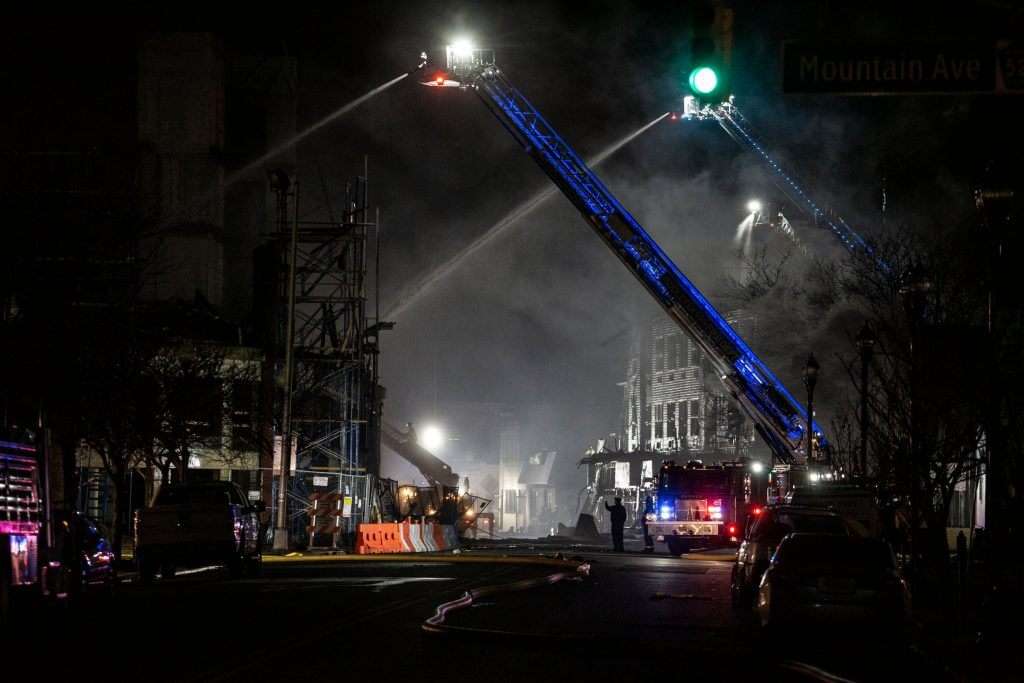 Fighting the fire that destroyed multiple buildings in Bound Brook, New Jersey
Fighting the fire that destroyed multiple buildings in Bound Brook, New JerseyImage source: The New York Times
The fire started in the basement and spread to an adjacent building, eventually destroying four buildings of which two were under construction.
Especially in densely constructed areas firewalls can be an excellent solution to stop or slow down the spread of fire, giving firefighting crews enough time to control and extinguish the fire.
Storage And Management Of Hazardous Materials And Liquids
Combustible and hazardous materials present a high risk for causing a fire to start or to spread rapidly. That’s why it’s essential to store them separately and label them clearly. This will help not only construction workers but also firefighters.
Management Of Waste
Keep the waste to the absolute minimum and remove it as soon as possible. Make sure waste doesn’t pile up near the entrances and emergency exits.
Ensuring The Safety Of The Scaffolding
A fire broke out on Macquarie Street in Sydney’s CBD, around 8 a.m. local time. 70 firefighters and 12 fire trucks tried to take control over the fire for several hours.
This time, the building the fire caught was undergoing renovation. The cause of the fire was not determined, but it was believed to be “a faulty electrical appliance that ignited the mesh”. At the same time, this incident reveals another risk related to construction site fires – scaffolding.
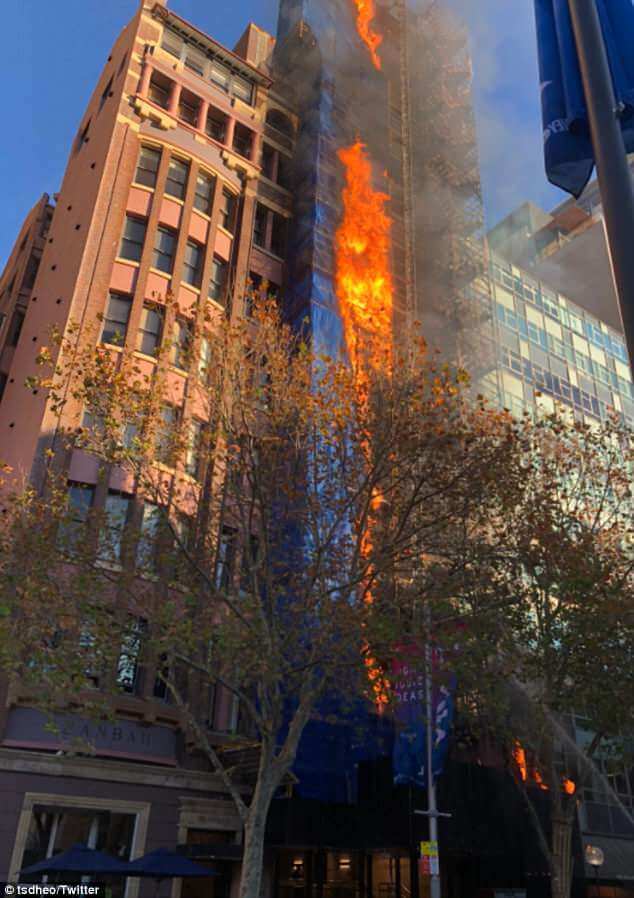
Fire in an office tower on Macquarie Street in the heart of Sydney
Image Source: Daily Mail
Scaffolding is “a temporary structure to support the original structure” while the building work is in progress.
In this case, the witnesses saw “the fire burn its way up the plastic, covering the outside of the scaffolding”. The fire destroyed the scaffolding which had been erected to remove the existing cladding (ironically, the cladding itself had been identified as a fire-risk and had already been removed).
Scaffolds may pose additional hazards because being temporary structures, they lack fire resistance and automatic fire sprinkler systems. Also, there is limited access to upper levels.
Safety Briefings
Safety briefings are particularly helpful to stay on top of the latest tasks and the hazards related to them. If done on a daily basis, these short meetings may decide how effective and quick your staff is when the emergency arises.
When a deadly fire broke out on an apartment building construction site in Denver, the state officials tried to find out how many people were on the site at the moment. The foreman didn’t know the answer to this question…
An old saying comes to mind here: “Safety is a full-time job. Don’t make it a part-time practice”.
By the way, let’s see who takes the responsibility for fire safety on building sites?
Who Is Responsible For Fire Safety In Buildings Under Construction?
The Victorian Building Authority has the answer.
Designers or architects must provide detailed blueprints and plans to give the builder a solid ground for complying with the requirements.
Builders, site supervisors, and project managers are responsible for ensuring that the fire precautions are installed in the building while it is under construction.
Building surveyors, building inspectors, and engineers should carry out inspections and make sure fire services are in place and comply with the relevant laws and regulations.
No matter your job description or the official requirement, it’s good to remember that safety is everybody’s job, and safe workplaces are created well before the hammer hits the nail.
What’s Next?
Quality training is the first step to gain the necessary knowledge and acquire the essential skill set. Expert coaches can teach how to cope with the toughest emergency challenges and how to act correctly in any situation.
No matter your field of interest or expertise, occupational health and safety, including fire safety, must be one of the major areas to explore, study and excel at.
Meet Back to Basics, a nationally recognized training provider that helps to get licensed in Site management, Project management, Contract Administration and other areas in building and construction.
Earning your Certificate or Diploma is quick, simple, and easy. Here is how we make it possible:
- You gain access to training materials developed by builders for builders.
- You receive one-on-one training from industry experts.
- You learn at your own pace.
- The price you pay is all-inclusive (textbooks are included).
- You become a member of our community.
If you would like more information on the courses Back to Basics offers or are interested in upgrading your resume with one of our qualifications, Call us on 1300 855 713 or email enquiries@backtobasics.edu.au to find out more.